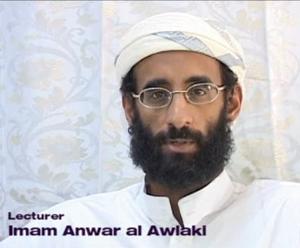Watch listsMost-wanted terrorist lists missing most wanted
Anwar Awlaki, the Yemen-based American Imam inciting Muslims to attack America, has been described by U.S. security officials as “terrorist number one” and as “the most significant risk to the U.S. homeland”; he is the first U.S. citizen ever placed on the CIA targeted killing list; yet, Awlaki remains inconspicuously omitted from federal most-wanted lists — and in January 2010, customs agents had Awlaki in custody at JFK International Airport in New York on an arrest warrant for passport fraud; according to classified immigration records, JFK agents were advised to release the detainee because the warrant had mysteriously “been pulled back” the day before; inquiring minds want to know what gives

In custody, a warrant "pulled" // Source: sudanforum.net
Appearing before Congress last week, National Counterterrorism Center Director, Michael Leiter, warned that Anwar Awlaki, the Yemeni lecturer credited with turning the Web into a tool for extremist indoctrination, is America’s new top terrorist threat. Despite being the first U.S. citizen ever placed on the CIA targeted killing list, the al Qaeda cleric has managed to elude the State Department’s Reward for Justice and FBI’s Most Wanted Terrorists lists. No reward is being offered for his capture, either.
Born in New Mexico in 1971, and having served as an imam in California and Virginia, Awlaki has been linked to Maj. Nidal Malik Hasan, the U.S. Army psychiatrist accused of killing thirteen people at Fort Hood, Texas, Umar Farouk Abdulmutallab, the Nigerian man who attempted to detonate a bomb on a Detroit-bound airliner on Christmas, two of the 9/11 hijackers, and Faisal Shahzad, the Pakistani-American man accused of rigging a car parked in Times Square with explosives.
Shahzad claimed that he had been inspired by the rhetoric of Awlaki’s sermons which encouraged every able Muslim to take arms against America, and to do so “without hesitation.”
In April 2010, the U.S. National Security Council (NSC) gave their consent to making Awlaki the first U.S. citizen ever placed on the CIA’s target list. Despite being called “terrorist number one” by Representative Jane Harman, (D-California) and National Counterterrorism Center Director, Michael Leiter, who said “”I actually consider al Qaeda in the Arabian Peninsula, with Awlaki as a leader within that organization, probably the most significant risk to the U.S. homeland,” Awlaki remains inconspicuously omitted from federal most wanted lists.
The U.S. Department of State’s Counter-Terrorism Rewards for Justice program (RFJ) was established by the 1984 Act to Combat International Terrorism. Administered by the State Department’s Bureau of Diplomatic Security, the RFJ aims to bring international terrorists to justice by encouraging the reporting of key information to prevent acts of terrorism, find their location, or disrupts their mode of financing.
Rewards range from under $1 million to $25 million, the current price on Osama bin Laden’s head, although the program also pays rewards “in cases where there is no prior reward offer, in appropriate circumstances.” The Web site contains the profiles of forty-three terrorists, while the FBI’s most wanted terrorist list features twenty-nine alleged terrorists that have been indicted by sitting Federal Grand Juries, yet neither mentions Awlaki.
In an effort during the Bush administration to obstruct terrorist funding, the Specially Designated Global Terrorist (SDGT) was used by the Treasury to freeze Awlaki’s assets. Progress made by Washington on disrupting Awlaki is being stymied by the reluctance of the FBI and State to advertise how at one point following 9/11, agents released him despite his private meeting with the hijackers, who followed him from a mosque in San Diego to a mosque outside Washington, not far from the Pentagon they attacked.
A year later, January 2010, customs agents had Awlaki in custody at JFK International Airport in New York on an arrest warrant for passport fraud. According to classified immigration records, JFK agents were advised to release the detainee because the warrant had mysteriously “been pulled back” the day before.
“We were stunned” that he was let go, said Ray Fournier, a federal agent who has been tracking Awlaki as part of a joint terrorism task force. “He was a high-value target. Everybody was excited about the prospect of hooking this guy up under a [criminal] charge to motivate a conversation with him regarding his relationship with the [9/11] hijackers.”
When asked to comment on the CIA’s secretive targeted killing list, CIA spokesman Paul Gimigliano said that it is “remarkably foolish in a war of this kind to discuss publicly procedures used to identify the enemy, an enemy who wears no uniform and relies heavily on stealth and deception.”
